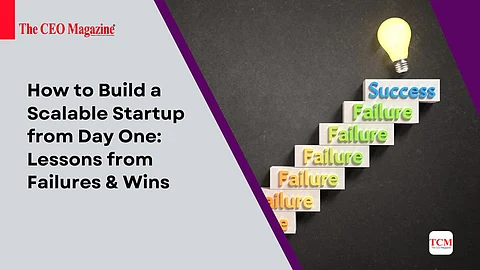
- News
- Women
- Magazine
- IndustryIndustry
- InsightsInsights
- Success Stories
- PublishPublish
- ContactContact
- Media KitMedia Kit

Let’s be real — the startup journey is brutal.
We all dream of launching something lean, disruptive, and world-changing. But most founders don’t realize one harsh truth:
It’s not the idea that wins — it’s the ability to scale.
In my experience working with dozens of founders and investors across India and globally, the pattern is clear.
The startups that succeed aren’t always the smartest — they’re the ones built for scale from day one.
So, how do you design your startup to grow — without breaking it in the process?
Let me show you, with hard-earned lessons from both failures and wins.
You’ve probably heard: “Build a minimum viable product and ship fast.”
That’s good advice. But here’s what’s often missing:
Your MVP must be the foundation for scale — not just proof of concept.
Can this product serve 10x the users without manual effort?
Is my backend architecture designed for growth?
Am I solving a problem that actually grows as I grow?
From Day 1, automate what you can, document what you must, and avoid duct-tape solutions that don’t scale.
Real-World Example:
Dropbox didn’t start with fancy tech. It started with a viral demo video. But behind that, the team focused obsessively on building a scalable cloud infrastructure from the start — not just a file-sharing app.
Here’s a lesson I learned the hard way:
A+ founders often hire B players, who then hire C players.
And that’s how a startup becomes a stagnant team.
Hire people who grow with the business — not just fill today’s gaps.
Build a culture of ownership, speed, and learning.
Invest early in systems (OKRs, clear onboarding, documentation) so scaling the team doesn’t dilute quality.
“Culture eats strategy for breakfast.” — Peter Drucker
Pro Insight:
In my early ventures, I thought hustlers were enough. Later, I realized: Scalable companies are built by teams who don’t just work hard — they think long-term.
Want to waste two years?
Build something no one wants — or something only a few people want.
Talk to customers before you build.
Solve a pain so deep that customers would pay you — even if you're not perfect yet.
Track retention early. If people aren’t coming back, scaling will only multiply that problem.
Hard Truth:
Scaling a product with poor market fit is like pouring water into a leaking bucket — the more you pour, the faster you fail.
Example:
Quibi raised $1.75B but failed within six months — not because of tech or funding, but lack of product-market fit.
When your startup is small, it’s tempting to do things manually — personal customer calls, hand-coded emails, one-off marketing tricks.
But here’s the secret:
If it doesn’t scale, don’t build your future around it.
CRM and marketing automation from Day One (even if it’s basic)
Onboarding flows that don’t need hand-holding
Templates, SOPs, and checklists for recurring processes
What I recommend:
Start with Zapier, Notion, and HubSpot to automate workflows, manage docs, and organize leads — even if you're a team of three.
Your business model is your growth engine.
If it doesn’t scale, nothing else matters.
Is your revenue model recurring or one-time?
Does revenue increase with each new customer, or does cost rise too?
Can your margins improve as volume grows?
Example:
Slack built a “land and expand” model — start free, then grow within teams.
This model scales with adoption, not with marketing budget.
“Don’t just build a product people want. Build a business people want to stay with.” — My early mentor told me this, and it changed everything.
You don’t need to raise a million dollars to start — but if your startup can’t scale without capital, plan for it strategically.
Focus on capital efficiency: how much growth per dollar spent?
Don’t over-hire post-funding — over-scale is as dangerous as under-scale.
Know your unit economics before Series A.
Investor Tip:
When pitching, show how $1 today becomes $3 tomorrow, not just how you’ll “acquire users.”
Related Read:
How to Attract Investors with a Scalable Startup Model
Some of my most painful lessons came from watching friends, clients, and even my own early ventures flame out.
Here’s what I’ve noticed:
Scaling before validation: Growth only amplifies cracks.
Founder burnout: Trying to do everything solo.
No feedback loop: Ignoring customer signals while chasing the next feature.
Ask Yourself:
What feedback are you ignoring right now?
Is your growth healthy — or just hype?
Quote to Reflect On:
“Success is a lousy teacher. It seduces smart people into thinking they can’t lose.” — Bill Gates
Let me leave you with this:
Your startup doesn’t need to be a unicorn tomorrow.
But it must be designed to become one — with the right mindset, systems, people, and product fit from day one.
And remember…
Scaling isn’t a moment. It’s a mindset.
So, whether you’re still in ideation or already shipping your first product — ask yourself daily:
Is what I’m building today going to break when I grow tomorrow?
If the answer is yes, go back.
If the answer is no, you’re already on your way.
Enjoyed this?
Share it with a fellow founder or startup team. Let’s build smarter, together.
Follow us on Google News
